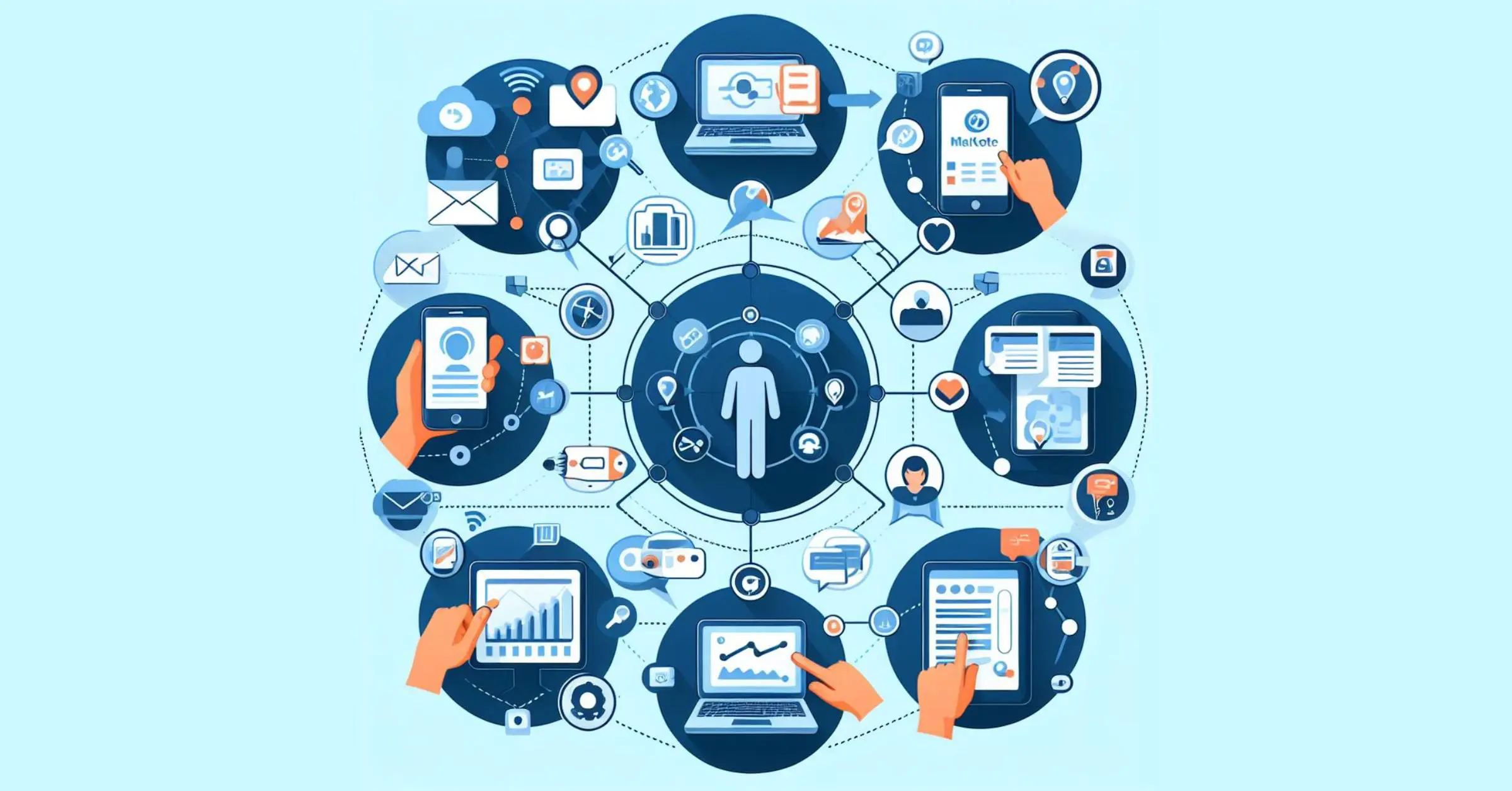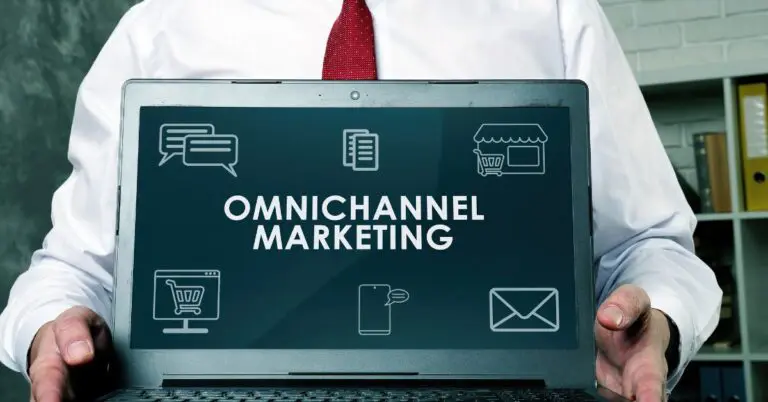In the ever-evolving world of digital marketing, staying ahead of the curve is crucial for small and medium enterprises (SMEs). Marketing automation has emerged as a powerful tool that can transform your marketing efforts, making them more efficient and effective. This comprehensive guide will walk you through the benefits, key components, and best practices of marketing automation, backed by data and empirical evidence.
Ready to take your marketing to the next level?
Book a meeting with our experts today and start leveraging the power of marketing automation.
Understanding Marketing Automation: A Comprehensive Overview

Marketing automation has revolutionized how businesses approach their marketing strategies, making it easier to streamline repetitive tasks and focus on more strategic initiatives. For small and medium entrepreneurs and marketers, understanding how to leverage marketing automation can be a game-changer in achieving efficiency and scalability.
Marketing automation refers to the use of software and technology to automate marketing tasks and workflows. This includes email marketing, social media posting, lead generation, and customer segmentation. By automating these processes, businesses can save time, reduce human error, and ensure a more personalized customer experience.
Benefits of Marketing Automation
- Increased Efficiency: Automating repetitive tasks allows marketing teams to focus on strategic planning and creative work. For example, HubSpot reports that businesses using marketing automation see a 14.5% increase in sales productivity and a 12.2% reduction in marketing overhead.
- Enhanced Customer Experience: Marketing automation tools enable personalized communication at scale. According to Salesforce, 67% of marketing leaders currently use a marketing automation platform, and 21% plan to use one in the next two years, primarily to improve customer experience.
- Data-Driven Decisions: Automation platforms provide robust analytics and reporting features. This data helps marketers understand customer behavior, measure campaign performance, and make informed decisions. A study found that 63% of companies outgrowing their competitors use marketing automation.
Key Components of Marketing Automation
- Email Marketing Automation: Automating email campaigns ensures timely and relevant communication with your audience. Tools like Mailchimp and ActiveCampaign allow for automated email sequences based on user behavior.
- Social Media Automation: Platforms such as Hootsuite and Buffer enable scheduling and posting across multiple social media channels, ensuring consistent engagement without manual intervention.
- Lead Nurturing and Scoring: Automation tools can track, and score leads based on their interactions with your brand, helping sales teams prioritize high-quality leads. According to Marketo, companies that excel at lead nurturing generate 50% more sales-ready leads at 33% lower cost.
- Customer Segmentation: Automated segmentation allows for targeted marketing efforts. By segmenting your audience based on demographics, behavior, or purchase history, you can deliver more personalized and effective campaigns.
Implementing Marketing Automation
To successfully implement marketing automation, follow these steps:
- Define Your Goals: Clearly outline what you aim to achieve with marketing automation, whether it’s increasing lead generation, improving customer retention, or enhancing campaign efficiency.
- Choose the Right Tools: Select a marketing automation platform that aligns with your business needs. Consider factors like ease of use, integration capabilities, and scalability.
- Train Your Team: Ensure your marketing team is well-versed in using the automation tools. Provide training sessions and resources to help them get up to speed.
- Monitor and Optimize: Continuously track the performance of your automated campaigns. Use the data to make necessary adjustments and optimize your strategies for better results.
Marketing automation is the technology that propels your business into a new era of relationship building and growth
-Jenna Hanington, Pardot
Key Benefits of Marketing Automation for Small and Medium Enterprises

Marketing automation has become a game-changer for small and medium enterprises (SMEs), providing tools and insights that were once only accessible to large corporations. By leveraging marketing automation, SMEs can streamline their marketing efforts, improve customer engagement, and drive revenue growth more efficiently.
1. Enhanced Efficiency and Productivity
One of the most significant benefits of marketing automation is the enhancement of efficiency and productivity. Automation tools can handle repetitive tasks such as email marketing, social media posting, and lead nurturing, freeing up valuable time for marketers to focus on strategy and creative work.
“Marketing automation drives a 14.5% increase in sales productivity and reduces marketing overhead by 12.2%.”
– Nucleus Research
2. Improved Customer Engagement and Personalization
Marketing automation allows SMEs to deliver personalized content to their audience, enhancing customer engagement. By segmenting their audience based on behavior, preferences, and demographics, businesses can send targeted messages that resonate with their customers. This personalization leads to higher open rates, click-through rates, and ultimately, conversions. Personalized emails deliver 6x higher transaction rates.
3. Data-Driven Decision Making
With marketing automation, SMEs gain access to valuable data and analytics that can inform their marketing strategies. These insights help businesses understand what works and what doesn’t, allowing them to make data-driven decisions. For instance, automation tools can track customer interactions and behaviors, providing a clear picture of the customer journey. This data can be used to optimize campaigns, improve customer experiences, and increase ROI.
4. Cost-Effective Marketing
For SMEs, budget constraints are often a significant challenge. Marketing automation offers a cost-effective solution by maximizing the impact of marketing efforts without the need for a large team. By automating tasks and utilizing data to refine strategies, businesses can achieve better results with fewer resources. A study by the Annuitas Group found that businesses using marketing automation to nurture prospects experience a 451% increase in qualified leads.
5. Consistent Multi-Channel Campaigns
Marketing automation enables SMEs to maintain consistency across multiple channels, ensuring that their brand message is cohesive and recognizable. Whether it’s email, social media, or website content, automation tools help manage and synchronize campaigns, providing a seamless experience for customers. This consistency is crucial for building brand trust and loyalty.
Discover your brand’s omnichannel potential with our comprehensive maturity assessment.
Omnichannel Maturity: Assess, Align, and Advance
Evaluate your current capabilities, identify areas for improvement, and chart a course towards delivering seamless, personalized experiences across all customer touchpoints.

Marketing automation offers numerous benefits for SMEs, from enhanced efficiency and productivity to improved customer engagement and data-driven decision-making. By leveraging these tools, small and medium enterprises can compete more effectively in the marketplace and drive sustainable growth. As we move towards the conclusion and call to action of this article, it’s essential to consider how these benefits can be practically implemented in your business strategy.
Selecting Optimal Marketing Automation Tools: A Data-Driven Strategy

The marketing automation industry is growing rapidly!
Between 2021 and 2023, the global marketing automation industry revenue grew by an estimated 22 percent to 5.86 billion U.S. dollars.
Marketing automation – statistics & facts | Statista
In this context, choosing the right marketing automation tools can be a game-changer. The right tools not only streamline your marketing efforts but also provide valuable insights that drive growth. However, the plethora of options available can be overwhelming. A data-driven approach ensures that your choices are backed by empirical evidence, maximizing your return on investment.
Understanding Your Needs
Before diving into the myriad of tools available, it’s crucial to understand your specific needs. Are you looking to automate email marketing, social media campaigns, customer relationship management (CRM), or analytics? Identifying your primary objectives will narrow down your options and make the selection process more manageable. If you haven’t already done it, you need to start by mapping your funnel.
Evaluating Features and Capabilities
Once your needs are clear, evaluate the features and capabilities of potential tools. Look for functionalities that align with your goals. For instance, if email marketing is a priority, tools with robust segmentation and personalization features should be on your radar. Similarly, if analytics is crucial, opt for tools that offer comprehensive reporting and data visualization.
Cost-Benefit Analysis
Conducting a cost-benefit analysis is essential. While some tools may offer extensive features, they might come with a hefty price tag. Compare the costs against the potential benefits to ensure you’re making a financially sound decision. Remember, the most expensive tool isn’t always the best; it’s about finding the right fit for your business needs.
Integration with Existing Systems
Another critical factor is the tool’s ability to integrate with your existing systems. Seamless integration ensures that data flows smoothly between different platforms, enhancing efficiency and reducing manual work. Check for compatibility with your current CRM, email marketing software, and other essential tools.
User Experience and Support
The user experience (UX) and support provided by the tool’s vendor can significantly impact your overall satisfaction. Opt for tools that are intuitive and easy to use. Additionally, robust customer support can be a lifesaver when you encounter issues. Look for vendors that offer comprehensive support, including tutorials, live chat, and dedicated account managers.
Empirical Evidence and Case Studies
Leverage empirical evidence and case studies to inform your decision. Many vendors provide case studies showcasing how their tools have benefited other businesses. These real-world examples can offer valuable insights into the tool’s effectiveness and potential ROI. Remember, the best marketing automation tools are those that not only meet your current needs but also scale with your business as it grows.
Making the Final Decision
After thorough evaluation, it’s time to make the final decision. Create a shortlist of tools that meet your criteria and consider taking advantage of free trials or demos. This hands-on experience can provide a clearer picture of how the tool will perform in your specific context.
Implementing Marketing Automation: Best Practices and Common Pitfalls

Marketing automation has revolutionized how small and medium-sized enterprises (SMEs) and marketers approach their strategies. By streamlining repetitive tasks, it allows businesses to focus more on creative and strategic initiatives. However, implementing marketing automation effectively requires a careful approach to avoid common pitfalls.
Best Practices for Marketing Automation
- Define Clear Objectives: Before diving into marketing automation, it’s crucial to set clear, measurable goals. Whether it’s increasing lead generation, improving customer retention, or boosting sales, having a defined objective will guide your automation strategy and ensure alignment with your overall business goals.
- Segment Your Audience: One of the most powerful features of marketing automation is the ability to segment your audience. By categorizing your contacts based on behaviors, demographics, or purchase history, you can tailor your messaging to resonate more effectively with each group. This personalized approach can significantly enhance engagement and conversion rates.
- Create Quality Content: Automation can distribute your content efficiently, but the content itself must be valuable and relevant. Invest time in creating high-quality content that addresses the needs and pain points of your audience. This will not only attract but also retain your target customers.
- Test and Optimize: Continuous testing and optimization are key to maximizing the effectiveness of your marketing automation efforts. A/B testing different email subject lines, call-to-action buttons, and landing pages can provide insights into what works best for your audience. Use these insights to refine your strategies continually.
“Marketing automation is not a set-it-and-forget-it tool. It requires constant monitoring and tweaking to achieve the best results.”
– MarketingProfs
Common Pitfalls to Avoid
- Over-Automation: While automation can save time, over-reliance on it can lead to impersonal interactions. It’s essential to strike a balance between automation and human touch. Ensure that your automated messages still feel personal and relevant to the recipient.
- Neglecting Data Quality: The effectiveness of your marketing automation is only as good as the data it relies on. Ensure that your data is clean, accurate, and up-to-date. Regularly audit your database to remove duplicates, correct errors, and update outdated information.
- Ignoring Analytics: Failing to monitor and analyze your automation efforts can lead to missed opportunities for improvement. Utilize analytics to track the performance of your campaigns and make data-driven decisions. This will help you identify what’s working and what needs adjustment.
- Lack of Integration: Marketing automation should not operate in a silo. Integrate your automation platform with other tools and systems, such as your CRM and social media platforms, to ensure a seamless flow of information and a more cohesive marketing strategy.
Implementing marketing automation can significantly enhance your marketing efforts if done correctly. By following best practices and avoiding common pitfalls, SMEs and marketers can leverage automation to achieve their business goals more efficiently. As you move forward, remember to continuously monitor, test, and optimize your strategies to stay ahead in the competitive market.
For more insights on how to effectively implement marketing automation, visit HubSpot’s comprehensive guide.
Scaling Personalization: The Role of Automation in Boosting Customer Engagement

Today, the ability to deliver personalized experiences to customers is no longer a luxury but a necessity. This is true even in the B2B space.
…a fundamental shift in how B2B buyers research and make purchase decisions. They expect a more B2C Inspired Experience, driven by digital interactions and self-guided exploration.
Pranesh Nagarajan on LinkedIn
Marketing automation has emerged as a powerful tool that allows businesses to achieve this personalization at scale, ensuring that every customer feels valued and understood.
The Power of Personalization
Marketing automation enables businesses to gather and analyze vast amounts of customer data, which can then be used to create highly personalized marketing campaigns. This data-driven approach ensures that each customer receives content that is relevant to their interests and needs, leading to higher engagement rates and increased customer loyalty.
“Personalization can reduce acquisition costs by as much as 50%, lift revenues by 5% to 15%, and increase the efficiency of marketing spend by 10% to 30%.”
– McKinsey
Key Benefits of Marketing Automation for Personalization
- Segmentation: Automation tools allow businesses to segment their audience based on various criteria such as demographics, behavior, and purchase history. This segmentation enables more targeted and effective marketing campaigns.
- Dynamic Content: Automated systems can deliver dynamic content that changes based on the user’s behavior and preferences. This ensures that each interaction is personalized and relevant.
- Behavioral Triggers: Automation can set up triggers based on customer actions, such as abandoned cart emails or personalized product recommendations, to re-engage customers and drive conversions.
Real-World Examples
- Email Campaigns: Automated email marketing platforms can send personalized emails to customers based on their browsing history, past purchases, and other behaviors. This level of personalization can significantly improve open and click-through rates.
- Social Media: Automation tools can schedule and publish personalized content on social media platforms, ensuring that each post resonates with the target audience.
- E-commerce: E-commerce businesses can use automation to recommend products based on a customer’s previous purchases and browsing history, enhancing the shopping experience and increasing sales.
Challenges and Solutions
While marketing automation offers numerous benefits, it also comes with its own set of challenges. These include data privacy concerns, the complexity of integration, and the need for continuous optimization. However, these challenges can be mitigated by:
- Ensuring Data Privacy: Implementing robust data protection measures and being transparent with customers about how their data is used.
- Seamless Integration: Choosing automation tools that easily integrate with existing systems and platforms.
- Continuous Optimization: Regularly analyzing campaign performance and making necessary adjustments to improve effectiveness.
To fully leverage the power of marketing automation for personalization, businesses must invest in the right tools and strategies. By doing so, they can create meaningful and engaging customer experiences that drive long-term loyalty and growth.
Ready to take your marketing to the next level?
Book a meeting with our experts today and start leveraging the power of marketing automation.
Measuring Success: Key Metrics and KPIs for Marketing Automation

Marketing automation can be a game-changer for small and medium entrepreneurs, but its true value is realized only when success is measured accurately. By focusing on key metrics and KPIs, businesses can fine-tune their strategies and ensure they are on the right track.
Key Metrics to Track
- Conversion Rate: This is the percentage of visitors who take a desired action, such as making a purchase or filling out a form. A high conversion rate indicates that your marketing efforts are effective.
- Click-Through Rate (CTR): This metric measures the percentage of people who click on a link in your email or ad. A higher CTR means your content is engaging and relevant to your audience.
- Customer Acquisition Cost (CAC): This is the total cost of acquiring a new customer, including marketing and sales expenses. Lowering your CAC while maintaining or increasing your customer base is a sign of efficient marketing.
- Return on Investment (ROI): ROI measures the profitability of your marketing campaigns. It is calculated by dividing the net profit by the total marketing costs. A positive ROI indicates that your campaigns are generating more revenue than they cost.
- Lead-to-Customer Ratio: This metric shows the percentage of leads that convert into paying customers. A higher ratio suggests that your lead nurturing process is effective.
Data-driven decision making is crucial for marketing automation success. By focusing on the right metrics, businesses can optimize their strategies and achieve better results.
Supporting Evidence
- Conversion Rate: According to HubSpot, companies that use marketing automation see a 53% higher conversion rate than those that do not.
- Click-Through Rate: A study by Mailchimp found that segmented email campaigns have a 14.31% higher open rate and a 100.95% higher click-through rate than non-segmented campaigns.
- Customer Acquisition Cost: Salesforce reports that businesses using marketing automation can reduce their customer acquisition costs by up to 12.2%.
- Return on Investment: A report by Nucleus Research found that marketing automation drives a 14.5% increase in sales productivity and a 12.2% reduction in marketing overhead.
- Lead-to-Customer Ratio: According to Forrester, companies that excel at lead nurturing generate 50% more sales-ready leads at 33% lower cost.
Practical Steps to Measure Success
- Set Clear Goals: Define what success looks like for your business. Whether it’s increasing sales, improving customer retention, or generating more leads, having clear goals will help you measure your progress.
- Use Analytics Tools: Leverage tools like Google Analytics, HubSpot, or Salesforce to track your metrics and KPIs. These tools provide detailed insights into your marketing performance.
- Regularly Review and Adjust: Continuously monitor your metrics and make adjustments as needed. Regular reviews will help you identify what’s working and what needs improvement.
- Benchmark Against Industry Standards: Compare your metrics with industry benchmarks to see how you stack up against your competitors. This will give you a better understanding of your performance.
Future Trends in Marketing Automation: Staying Ahead of the Curve

Marketing automation is evolving at a breakneck pace, and staying ahead of the curve is crucial for small and medium entrepreneurs and marketers. As technology advances, the tools and strategies that define marketing automation are becoming more sophisticated, offering unprecedented opportunities for businesses to connect with their audiences in meaningful ways.
AI and Machine Learning Integration
Artificial Intelligence (AI) and Machine Learning (ML) are no longer just buzzwords; they are transforming the landscape of marketing automation. By leveraging AI, businesses can analyze vast amounts of data to predict customer behavior, personalize marketing messages, and optimize campaign performance. For instance, AI-driven tools can segment audiences more accurately and tailor content to individual preferences, enhancing engagement and conversion rates.
“AI and ML are revolutionizing marketing automation by enabling more precise targeting and personalized customer experiences.”
– MarketingProfs
Omnichannel Marketing
The future of marketing automation lies in creating seamless experiences across multiple channels. Omnichannel marketing ensures that customers receive consistent and personalized messages whether they interact with your brand via email, social media, or in-store. This approach not only improves customer satisfaction but also drives higher conversion rates.
Key benefits of omnichannel marketing include:
- Enhanced Customer Experience: Providing a unified and personalized experience across all touchpoints.
- Increased Engagement: Engaging customers on their preferred platforms.
- Better Data Insights: Gaining comprehensive insights into customer behavior across channels.
Predictive Analytics
Predictive analytics is another trend that is gaining traction in marketing automation. By analyzing historical data, predictive analytics tools can forecast future trends and customer behaviors. This allows marketers to make data-driven decisions, optimize their campaigns, and allocate resources more effectively.
For example, predictive analytics can help identify which leads are most likely to convert, enabling sales teams to prioritize their efforts and improve efficiency.
Chatbots and Conversational Marketing
Chatbots are becoming an integral part of marketing automation strategies. These AI-powered tools can handle customer inquiries, provide personalized recommendations, and even assist in the purchasing process. Conversational marketing, facilitated by chatbots, allows businesses to engage with customers in real-time, providing instant support and enhancing the overall customer experience.
“Chatbots are revolutionizing customer service by providing instant, personalized interactions that drive engagement and sales.”
– HubSpot
Data Privacy and Compliance
As marketing automation becomes more data-driven, ensuring data privacy and compliance is paramount. With regulations like GDPR and CCPA, businesses must prioritize data security and transparency. Implementing robust data protection measures and staying compliant with regulations will not only protect your business from legal repercussions but also build trust with your customers.
Staying ahead of the curve in marketing automation requires embracing these future trends and integrating them into your strategies. By leveraging AI, adopting omnichannel marketing, utilizing predictive analytics, incorporating chatbots, and prioritizing data privacy, you can ensure your business remains competitive and responsive to evolving customer needs.
Transform Your Marketing Strategy
Marketing automation offers a myriad of benefits, from increased efficiency and personalized customer engagement to data-driven decision-making and cost-effective marketing. By understanding and implementing the right tools and strategies, SMEs can significantly enhance their marketing efforts and drive sustainable growth. Stay ahead of the curve by embracing future trends like AI integration, omnichannel marketing, and predictive analytics. To explore how marketing automation can revolutionize your business, don’t hesitate to book a meeting with our experts. Let’s take your marketing to new heights together.




